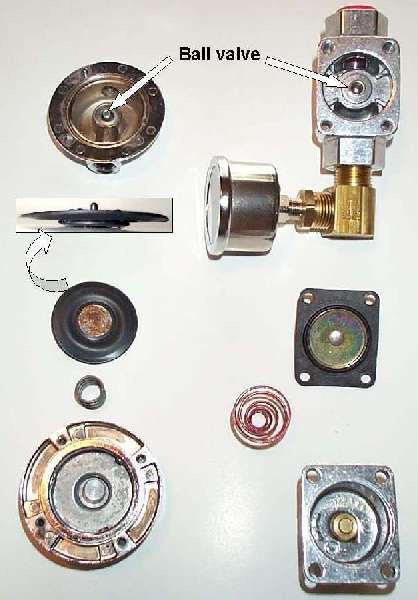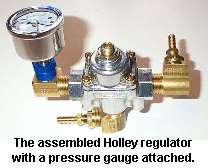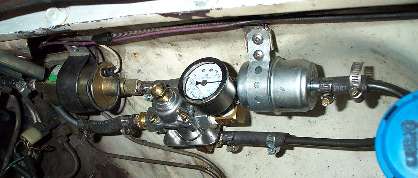 Just a Simple Wrench
Just a Simple Wrench
by Ann & Jake Snyder
Under Pressure
(an email from one of us to the other in mid-March)
>>Subject: fuel pressure regulator
Hi,
We will need another spare fuel pressure regulator for the 73, because I used the spare this morning. I had stopped at home after my visit to the dentist and decided to get fuel on my way back to work. I started out to do that, but the car died just as I got to the corner of Gurney and Center. That’s exactly how far I got the last time the pressure regulator jammed, so I got out, turned the control up and down, and fuel spurted into the filter. The car then ran fine until after I left the gas station, when it lost power after about a block. I was able to pull onto one of the side streets, went through the routine, and drove away again. The third time it failed was after I turned onto Rockland Road, and this time I was able to pull into the parking lot by Dominicks.
I didn’t like the idea of making the rest of the trip in quarter mile increments, and besides, “exercising” the regulator didn’t seem to be letting much fuel through this time. I checked the parts bag and found that we did, in fact, have a spare regulator. I would have settled for enough hose to take the regulator out of the system, but was happier to be able to replace it.
Yes, I wore my safety goggles. I knew that the fuel would be under pressure where it entered the regulator. You will remember that when we were doing a tech session on roadside problem diagnosis, we suggested having a container handy to catch fuel when checking the lines. I found that it is not always easy to come up with something suitable. One of your travel mugs was behind the seat, but I didn’t really want to use that. I emptied a plastic water bottle, but could not find a knife to cut it open (must start carrying my pocket tool again). I was able to puncture it with the flat blade of a screw driver and then tear off the top. I released one clamp partially and was able to catch nearly all of the fuel that was under pressure. Replacing the regulator was no problem. I did not find any Teflon tape in the bag (maybe I just didn’t have the patience to look hard enough), so we may want to put some on the fitting threads soon.
If we plan to do the Missouri rally, we not only have to check over the car, but also need to carefully go through the parts and tools bags. Luckily, the fittings for the regulator were 7/16". I looked first for a 1/2" open end, and found that the roll of wrenches has combination wrenches in every size except that. The only 1/2" that I found (again, maybe I didn’t take time to look thoroughly) was a box with 9/16 on the other end. I also used the last two vinyl gloves, so we will need to replace those. The 4-way screw driver was really handy for loosening the hose clamps and the hold-down clip, which uses a Phillips screw.
I checked carefully for leaks. I guess my only previous roadside fuel system repair has been whacking the fuel pump with a wrench. The car ran perfectly - I let the speed drop a couple times so that I could accelerate and invoke the supercharger, and it behaved normally.
ttyl,
That evening we took apart the malfunctioning pressure regulator. We have used fuel pressure regulators in our MGs for many years, and infrequently, when restarting a motor that is already warm, they actually block the flow of petrol, so that the car loses power from fuel starvation. Why use a pressure regulator in the first place? We drive our MGs daily and for long trips, and since it is impossible to predict when a fuel pump will fail, we equip each car with a spare inline low pressure electrical pump that can be connected at a moment’s notice. The output of such pumps is usually higher than the 1.5 psi that is appropriate for our SU carburetors- hence the pressure regulator. In every previous case, the remedy for a malfunctioning regulator had been to turn the adjusting knob up to its maximum and then back to the 1.5 setting.

Disassembled pressure regulators. The Profuel is on the left and the Holley is on the right. The inset shows the Profuel diaphragm as seen on edge.
On this type of regulator (disassembled on the left in photo above), as the adjuster knob is moved to higher settings, it exerts increasing pressure, via a spring, on the center of a rubber diaphragm. The insert shows the opposite side of the diaphragm as seen from the edge. The protrusion in the center of the diaphragm presses against the stem of a metal ball valve, which allows fuel to flow into the compartment created by the regulator housing and the diaphragm. Technically, these are not as much pressure regulators as flow (volume) restrictors. We found that the rubber appeared to have lost some of its resilience with time, possibly as a result of exposure to fuel additives. While we are not in complete agreement about why the regulator was completely restricting the flow of fuel, our current theory (best guess) is that the loss of rigidity of the diaphragm allowed the stem of the ball valve to drift off center, with less deflection of the valve to allow fuel to enter the regulator.
 Since we were not willing to trust the calibration of this type of regulator, we invested in a genuine Holley pressure regulator. We also ordered a pressure gauge at the same time. The disassembled Holley regulator is shown on the right in photo above. The operation of this regulator is similar, but the diaphragm consists of a rigid frame that is connected to a central metal plate by a narrow circle of rubber. This seems to us to be an improved design, but apparently these are also prone to failure with time, because replacement diaphragms are available. Yes, we added one to the order.
Since we were not willing to trust the calibration of this type of regulator, we invested in a genuine Holley pressure regulator. We also ordered a pressure gauge at the same time. The disassembled Holley regulator is shown on the right in photo above. The operation of this regulator is similar, but the diaphragm consists of a rigid frame that is connected to a central metal plate by a narrow circle of rubber. This seems to us to be an improved design, but apparently these are also prone to failure with time, because replacement diaphragms are available. Yes, we added one to the order.

The installed regulator and gauge. The auxiliary fuel pump is on the left; the fuel filter is on the right.
We did, in fact, drive in the Missouri Endurance Rally and had no problems with the regulator. The pressure gauge, however, is not a genuine Holley gauge. And that is another story. But as this is already getting long, we will save that for another time.
(Back to top)
|





